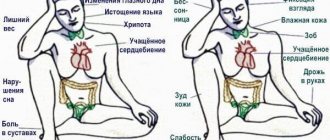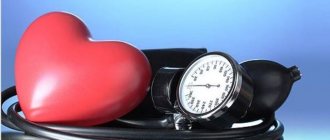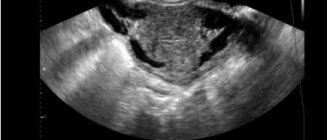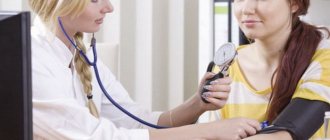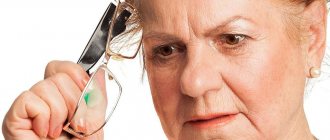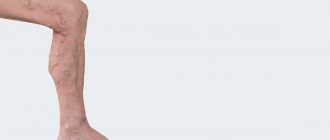Types of panic attacks
They can be spontaneous, situational and conditionally situational. The first ones arise suddenly and are not explained by the surrounding environment. Situational panic attacks are the body’s response to specific circumstances. Usually we are talking about some kind of stress or events that anticipate this stress. For example, a person knows that right now he will have a strong quarrel with someone, and he is very afraid of this.
A conditioned situational symptom manifests itself as a reaction to a single stimulus (usually chemical or biological) - for example, drinking alcohol, a significant dose of caffeine, or surges in certain hormones.
At its core, a panic attack is an emergency mode of the body - a similar reaction occurs at a time when a person feels serious danger. It’s just that in the case of this symptom, the reaction works “idlely” - when there is no real threat, but the body is still working at the limit.
Panic attacks - what are they?
The immediate cause of the formation of panic attacks lies in the powerful and sudden release of the hormone adrenaline into the blood, which is normally produced in a person under severe stress, fear, a sense of danger, borderline or shock states. Subjective reasons can be both real and far-fetched.
Panic disorder is often classified as a type of exacerbation of neurosis and vegetative-vascular dystonia. The attack usually lasts from several minutes to an hour and tends to become more frequent. Literally: at first the patient experiences anxiety once a month, later panic attacks can occur daily. The syndrome affects mainly young people 18-35 years old, but medical practice knows cases of attacks developing in old age. Men and women are equally susceptible to them, but in the second case this phenomenon occurs more often due to the characteristics of the psyche and perception.
Our multidisciplinary clinic “DIAMED OSTEO” employs qualified doctors who will help you not only cope with the symptoms of the disease, but also find out its exact cause. Our clinic is equipped with exclusively modernized equipment, and our doctors carry out all types of comprehensive diagnostics in accordance with European standards.
SYMPTOMS OF PANIC ATTACK
When experiencing a panic attack for the first time, a person cannot objectively assess what is happening and understand that he is faced with a serious problem. Most patients attribute the syndrome to fatigue and find an imaginary reason for the sudden surge of fear. Thanks to all these factors, diagnosis and therapy are put on hold, which creates favorable conditions for the disorder to evolve into a chronic form.
Let's take a closer look at how a true panic attack manifests itself. If you periodically experience a number of the above symptoms, we recommend that you do not put off visiting a specialist.
Panic attacks manifest themselves in the following signs:
- Acute unmotivated attack of panic, severe fear or anxiety;
- Thoughts about suddenly approaching death specifically at the moment;
- Intense heartbeat, tachycardia, significant increase in heart rate;
- Confusion of thoughts, lack of clarity of consciousness;
- Hyperhidrosis, feeling of “cold sweat”;
- Severe tremors in the limbs;
- Chills;
- Feeling of lack of oxygen, suffocation, difficulty breathing;
- Tingling or numbness on the left side of the chest;
- An attack of nausea or polyuria (increased urine production);
- Severe dizziness and darkening of the eyes, bordering on syncope;
- Excessive lightness in the head and body;
- Allopsychic depersonalization and derealization;
- Tingling and numbness in the limbs;
- Alternating flashes of heat and cold;
- Panic fear of going crazy or performing an uncontrollable action.
AT-RISK GROUPS
Panic attacks are becoming more common among young and adult populations. There are a number of objective and subjective reasons for this. First of all, these include concomitant diseases - they are the main etiological factor of the disorder. However, some negative aspects of your lifestyle can contribute to its occurrence, even if you do not have a history of neuroses or mental disorders, and also do not suffer from vegetative-vascular dystonia.
The following factors can trigger panic attacks:
- Personal predisposition (emotional lability, tendency to “take everything to heart”, suspiciousness);
- Low stress resistance;
- Experienced psycho-emotional shocks;
- Constant stress;
- Neuroses;
- Vegetative-vascular dystonia;
- Chronic fatigue syndrome;
- Nervous tension;
- Hard physical work and overwork on its background;
- Depressive disorders;
- Somatic disorders;
- Endocrine imbalance;
- Severe diseases of the nervous system;
- Pregnancy (fear of spontaneous abortion or the birth of a sick baby);
- Intellectual, emotional and mental overload;
- Taking medications with a high content of stimulants;
- Constant conflicts in the team and family;
- History of physical or sexual violence (including in children);
- Parasomnias and insomnias;
- Genetic factor;
- Alcohol abuse;
- Use of narcotic substances, stimulants and antidepressants (without medical prescription).
WHY DO YOU NEED A VISIT TO A SPECIALIST?
Relieving the symptoms of a disease or disorder has never resulted in a cure. On the contrary: by relieving an uncomfortable state with the help of sedatives and tranquilizers, especially those chosen independently, you feed your problem from the inside, provoking its relapses and rapid development. You must understand: only by eradicating the cause of the disease can you achieve complete recovery.
Unfortunately, there are many unscrupulous medical professionals who prefer to act on the principle of relieving symptoms without making any effort to study the etiology of the disease and eliminate its root cause. Therefore, we recommend that you contact only qualified, experienced professionals who will conduct a thorough diagnosis and direct therapeutic measures directly to the root of your problem.
A few basic rules you must adhere to:
- If you detect alarming signs of a disorder, immediately consult a doctor to establish a diagnosis and begin adequate therapy;
- Do not self-medicate under any circumstances. By attempting to find antidepressants or tranquilizers for yourself, you risk developing even more severe mental health problems;
- Practice self-control. A panic attack can be suppressed without resorting to the use of medications. If seeing a doctor is not possible right now, take a horizontal position, restore your breathing, tune in to a positive “wave,” and drink water. These simple actions will allow you to avoid the terrible consequences of a panic attack (for example, suicide);
- Avoid stressful and conflict situations;
- Do not hesitate to ask passers-by to help you if an attack takes you by surprise in a public place;
- Follow all the rules recommended to you by your doctor, be it a regimen of medications, a behavioral factor, or lifestyle correction;
- Give up bad habits, eliminate alcohol, nicotine and natural stimulants from your life;
- Get checked regularly by specialists.
WHAT CAN A PANIC ATTACK INDICATOR?
We have understood the symptoms and causes of this disorder and would also like to emphasize the fact that a panic attack itself may indicate an ongoing illness, i.e. become its consequence.
So, a panic attack can be a symptom of the following diseases:
- Benign or malignant tumor processes of the adrenal cortex;
- Severe phobias;
- Wolff-Parkinson-White syndrome;
- Multiple sclerosis;
- Leigh syndrome;
- Somatoform disorders;
- MDD (clinical depression);
- Diabetes;
- Autoimmune thyroiditis;
- Hypothyroidism or hyperthyroidism;
- Myocardial infarction;
- Cardiac ischemia;
- Atherosclerosis;
- Heart failure.
As you understand, all these diseases are serious, and you can find out if you have them by contacting a neurologist with complaints of panic attacks. This is another point that should prompt you to be examined by a specialist, because a panic attack can be a completely harmless syndrome in comparison with what happens to the body as a whole.
A panic attack can seriously unsettle you and disrupt your quality of life. In addition, the syndrome often becomes a sign of severe concomitant diseases. We recommend that you seek help from specialists in a timely manner to avoid progression of the disease and an increase in symptoms. In our clinic you will always receive decent, competent assistance and support in the fight against serious illnesses.
Causes of a panic attack
It is important to understand that the idea that panic attacks are 100% related to mental disorders is completely wrong. Yes, such a symptom can be explained by various mental disorders - for example, it occurs in low-grade schizophrenia, and often accompanies hypochondria or neuroses of various types. It also accompanies some types of depression. But it doesn't stop there. Sometimes panic attacks are atypical manifestations of somatic diseases, and in this case, doctors do not immediately connect one with the other.
Situations are very common when a symptom is explained by the presence of neurological disorders. This may be a disorder of the vestibular apparatus or some organic diseases of the brain.
A panic attack can be triggered by stress, accumulated fatigue, and the use of certain psychoactive substances. But all these are external factors that do not cause the problem on their own - they only stimulate it, pull it out from within, when it already exists against the background of the problems listed above.
After the first panic attack occurs, a person begins to return to this state again and again. The situation is aggravated by the fact that the very memory of this condition and its anxious anticipation contribute to the recurrence of attacks.
Vegetovascular dystonia: symptoms and treatment
The difficulty of making a diagnosis lies in the whole spectrum of symptoms. The disease skillfully mimics; two people with vegetative neurosis can have completely different complaints. However, there are three types of pathology:
- VSD of normotensive type. Characterized by abnormal heart rhythm.
- VSD of the hypertensive type. Characterized by increased blood pressure. The disease carries a risk of stroke, especially in older patients. With this type of VSD, the work of the heart is corrected by reducing heart rate with medication.
- VSD of hypothetical type. Characterized by a decrease in blood pressure. The patient experiences weakness, often fainting. Therapy is carried out with atropine and aminophylline. Along with medications, the patient is prescribed vitamins and medications with antioxidants. Green tea is beneficial.
The first signs of the disease are manifested by the following symptoms:
- From the side of blood vessels and the central nervous system.
Increased heart rate, headache and tinnitus, unusual sweating, muscle pain and trembling throughout the body, including the limbs.
- From the mental point of view.
Panic and obsessive states, sudden changes in emotions, anxiety and suspiciousness.
It is impossible to cover all the signs within the scope of this article (there are more than 150 of them). But our goal is not to make a diagnosis online. If you notice the first alarming symptoms, consult a doctor. The main thing is to be wary of VSD and understand that the disease can manifest itself with a whole range of symptoms.
Which doctor treats panic attacks?
Treating panic attacks is a multifaceted process. It is impossible to say right away which doctor will help eliminate this condition - in many cases you have to act by elimination: check the heart, endocrine system, and the condition of the brain. If no physical health problems are detected, you should definitely contact a psychotherapist.
Consultation with a neurologist and examination to rule out neurological causes is a mandatory solution for panic attacks. And if such a need arises, the Kuntsevo Multidisciplinary Treatment and Rehabilitation Center has both the technical capabilities for a high-quality study of the patient and doctors with extensive experience. Clients are offered MRIs, ultrasounds and other options to help identify the root of the problem. If it turns out that the causes of panic attacks relate to neurology or other areas of the clinic, patients will be offered high-quality treatment and rehabilitation in a comfortable environment.
Treatment of vegetative-vascular dystonia in men and women
With this diagnosis, it is necessary to carry out a complex of procedures. Treatment of vegetative-vascular dystonia in women and men should be carried out under the supervision of neurologists and other specialists. Self-therapy does not produce results. The following help to cope with dysfunction of internal organs and pathological changes:
- Physiotherapy. It has a general strengthening effect, promotes the regulation of vegetative activity at all levels.
- Physiotherapy – massage, reflexology.
- In drug treatment, modern medications are used when it is necessary to cope with serious functional disorders and severe neuroses.
Carrying out complex therapy allows you to completely restore all functions of the body. Cope with any type of VSD, including neurocirculatory, vegetoneurosis and other types. Only by contacting a specialist can a patient count on a full restoration of health and a return to a normal and fulfilling life.
Restoring normal life
It will consist not only of nutrition, exercise and the elimination of provoking factors. It is important that the patient monitors his health, avoids stressful situations, gets good sleep and avoids excessive stress. When the original cause has already been eliminated, a lot will depend on the person himself - his desire to get rid of the symptom and return to normal life.
As solutions that will help the patient establish the desired lifestyle, the Kuntsevo Medical and Rehabilitation Center offers physical therapy, physiotherapy, and massage. Many of the procedures are aimed not only at a specific problem, but also at increasing the level of happiness hormones - and this is important when treating panic attacks.
Vegetative-vascular dystonia: which doctor should I contact?
What are the causes of its occurrence, and which doctor should you contact to receive comprehensive treatment?
Degree of disease development
Depending on the severity of VSD, it is customary to divide it into the following stages:
- Initial. It is characterized by mild pain in the heart that occurs after emotional experiences or physical exertion. Exacerbations do not occur often.
- Average. The duration of periods during which exacerbation occurs increases.
- Heavy. Pronounced symptoms of the disease are almost always present. A rapid heartbeat is often observed, accompanied by PA (panic attacks).
Causes
The primary causes of the disease, as reported by the portal https://lechusdoma.ru/zabolevaniya/, may be associated with damage to the central nervous system of the child still in the womb. As a rule, this occurs in late pregnancy or directly during labor. In addition, VSD can begin to develop in children who live in an unfavorable family atmosphere, have problems communicating with peers, and also often experience stress, physical and nervous fatigue.
As for secondary causes, they manifest themselves as a result of pathological changes in the digestive, endocrine, nervous and cardiovascular systems, which are chronic. In addition, the development of VSD can be caused by a change in climatic conditions, addictions, allergies, poor diet, vitamin deficiency, frequent stress, depressive states, as well as spinal injuries and osteochondrosis.
Which doctor should I contact?
If there are signs of VSD that persist for 2 months or more, you should first visit a general practitioner and a cardiologist. An initial examination by these specialists will show whether the help of an endocrinologist, psychiatrist, ophthalmologist, gastroenterologist, neurologist, surgeon or ENT specialist is needed. Since only a highly specialized doctor will be able to correctly identify the problem and prescribe treatment that eliminates the cause of unpleasant symptoms.
Treatment of VSD is quite complex, so an integrated approach is required, including taking medications, normalizing sleep and daily routine, exercise therapy, water procedures and massage. Moreover, most patients notice improvements precisely after adjusting their diet, daily routine and giving up bad habits. In other words, lifestyle changes often help get rid of the symptoms of the disease.
Lifestyle during panic attacks
It is important for people who suffer from such symptoms to remember that they do not go away on their own—the situation will only get worse over time. At the same time, each time the body will experience enormous stress - an untimely sense of danger forces it to work at “maximum speed”. The sooner the patient begins a thorough examination and, with the help of doctors, discovers the causes, the less risk there is of aggravating the situation and causing additional illnesses.
Contact the Kuntsevo Treatment and Rehabilitation Center - they will help you!
Types and symptoms
In medical practice, VSD is divided into:
- cardiological type. Shortness of breath, sharp or dull pain in the chest, rapid heartbeat,
- tachycardial type. Vibration is felt in the vessels, the pulse quickens, the face turns red, the pain in the temples progresses,
- hypertensive type. The heart rate increases, blood pressure rises, legs go numb, chills are felt,
- visceral type. The pain is localized in the intestines and abdomen, there is a feeling of fullness, constipation or diarrhea appears,
- hypotonic type. Weakness, shortness of breath, nausea, sweating and low blood pressure are the main signs
- asthenic type. Characterized by fatigue, decreased stamina, loss of attention, trembling hands,
- respiratory type. You feel a lump in your throat, there is not enough air, there is a pressing pain behind the sternum,
- mixed type.
Exacerbation of VSD occurs sharply due to stress, poor nutrition, depression, hormonal imbalance, chronic diseases, etc. These symptoms are accompanied by severe unbearable pain.




